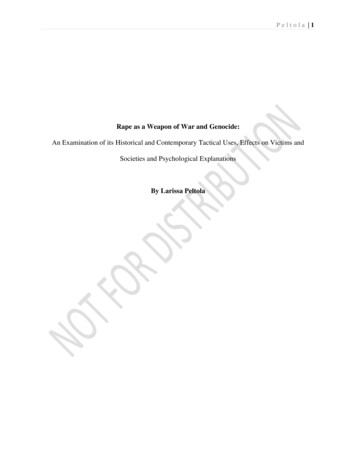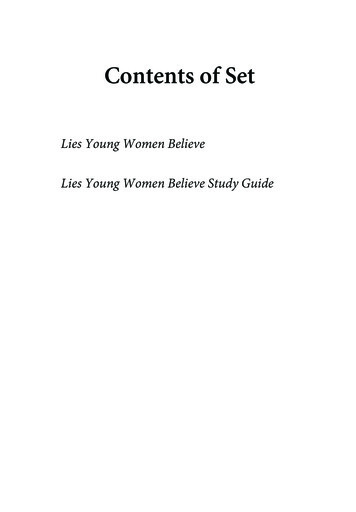
Transcription
781107108783C04.3D194[194–253] 25.4.2015 8:02AM4Lies, Rape, and Statutory RapeStuart P. Green*When a defendant lies or uses other forms of deceptionto induce an adult partner into sex, the law onlyrarely treats that as rape, even if the partner would nothave engaged in the act absent the deception.But when thedefendant himself is deceived into having sex with a partnerwho is underage, such deception is normally no defense tocharges of statutory rape, even if, once again, it was a “butfor” cause of the act. To put it another way, in the case ofrape, the lie-perpetrator normally escapes liability, while instatutory rape, the lie-victim is punished. At first glance,* An earlier version of this chapter was presented at the University ofAlabama Law School conference on “Law and Lies” and at a facultyworkshop at Cornell Law School, and I am grateful for the manyhelpful questions and comments I received. Special thanks to SherryColb, Bill Eskridge, Mary Anne Franks, Stephen Garvey, HelenNorton, Jens Ohlin, Austin Sarat, Ken Simons, and NormanSpaulding.194
781107108783C04.3D195[194–253] 25.4.2015 8:02AMLies, Rape, and Statutory Rapethis seems reversed. Why does deception play what seems tobe a morally inverted role in these two contexts? Can such aregime be justified?As the analysis below suggests, there is no neat answerto these questions. The law of rape and of statutory rape eachdeveloped according to their own logic, in their own historical contexts, in response to distinctive policy concerns. Still,it is worth considering the two offenses in relation to eachother, since both are ultimately concerned with questions ofsexual autonomy and consent to sexual relations, and bothare key components in a larger system of sexual offenses. Onthe view that I present here (and which will be developed inmuch greater detail in a book I am writing1), the law ofsexual offenses is understood as protecting a wide range of“sticks” that comprise the “bundle” of sexual autonomyrights. Under this view, individual sexual offenses likerape and statutory rape are understood as protecting specificcollections of sticks within that bundle, rather than sexualautonomy in toto.Given that rape is the most serious of the sexual offenses,one would expect it to protect the most serious of the sexualautonomy rights. These would include, at the least, the rightto decide whether or not to have sexual intercourse or otherpenetrative sex, and the right to decide whom one will have itwith. Thus, where D induced V into sex by lying about thefact that they were having sex (say, in the course of a1Tentatively titled Criminalizing Sex: A Unified Theory (under contract with Oxford University Press).195
781107108783C04.3D196[194–253] 25.4.2015 8:02AMStuart P. Greenfraudulent medical procedure), or about his identity (byimpersonating her regular lover), that would constituterape on my view. More difficult are cases in which D obtained sex from V by lying about matters, such as whether hewas married, using birth control, carrying a sexually transmitted disease, or interested in a long-term romantic relationship. While I shall not attempt to resolve all of theseissues in this brief chapter, I believe that the beginning ofan answer lies in determining – as we do in other legalcontexts, such as perjury and fraud – which kinds of deception are more wrongful or harmful than others.Thinking more broadly about the sexual offenses canalso shed light on the role that deception plays, or ought toplay, in the context of statutory rape. Like the law of rape,the law of statutory rape is concerned with protecting potential victims’ sexual autonomy – but it does so in a quiteconvoluted manner. Unlike adults, juveniles are not recognized as having sexual autonomy in those cases in whichthey genuinely wish to have sex; in such cases, lack of consent to sex is said to be “presumed.” Paradoxically, it is onlywhen juveniles are subject to truly unwanted sex – as in thecase of forcible rape – that their ability to consent is implicitly recognized. To avoid this paradox, I suggest that weabandon the idea of statutory rape as involving a presumption of nonconsent, and instead simply view it as analogousto other offenses that are intended to prevent the exploitation of potentially vulnerable members of society. Where the“victim” herself has used deception to induce the offender196
781107108783C04.3D197[194–253] 25.4.2015 8:02AMLies, Rape, and Statutory Rapeinto having sex, however, the prevention-of-exploitationmodel breaks down – indeed, is turned on its head – andthe rationale for imposing liability is thrown into doubt.I. Deception and the Law of Rape and Statutory RapeI begin with a brief description of how deception-inducedsex is currently treated in the law of rape and of statutoryrape.A. RapeAt common law, a successful prosecution for rape normallyrequired proof not only that the victim did not consent tointercourse but also that such intercourse was obtained by“force.” Indeed, the issues of nonconsent and force wereessentially merged: the only way to prove lack of consentwas by presenting evidence of force. This meant that nonconsensual sex obtained by means other than force, such asdeception or coercion, was generally not subject to prosecution as rape. Sex induced by deception was treated, if at all,under the law governing the tort (and, later, the lessercrime) of seduction.2 Thus, it was not rape if a man obtaineda woman’s consent to sex by falsely claiming, for example,that he loved her, was single, would marry her, was a famousmovie director, was using birth control, was sterile, or did2See Jane E. Larson, “Women Understand So Little, They Call MyGood Nature ‘Deceit’: A Feminist Rethinking of Seduction,”ColumbiaLaw Review 93 (1993): 374.197
781107108783C04.3D198[194–253] 25.4.2015 8:02AMStuart P. Greennot have a venereal disease.3 And this was true even if itcould be proved that the victim would not have had sex withthe defendant but for his lie.There were, however, two important exceptions to thegeneral rule: Courts generally held that it was rape if theman obtained consent to sex by deceiving his victim intobelieving that she was (1) undergoing a medical procedure,rather than intercourse, or (2) having sex with her spouse. Inso doing, the courts relied on a distinction, borrowed fromcommercial law, between “fraud in the factum” and “fraud inthe inducement.” Fraud in the factum was said to occurwhen the victim was unaware of the “true nature” of thetransaction into which she was entering.4 For example, if Xwas tricked into signing a document not knowing that it was,say, a contract or deed, that would be regarded as fraud inthe factum, and the document would have no legal effect.This was to be contrasted to cases of fraud in the inducement, in which X was deceived not about whether she wassigning a will or deed as such, but rather about the specificrights and obligations created by the documents. In suchcases, the deception was said to be “collateral,” and theagreement would be enforceable.5Applying the factum/inducement distinction in the context of sexual relations, courts held that it was rape if the345See generally Patricia J. Falk, “Rape by Fraud and Rape byCoercion,” Brooklyn Law Review 64 (1998): 39.People v. Morales, 212 Cal.App.4th 583, 594 (2013).McArthur v. Johnson, 61 N.C. 317, 319 (1867).198
781107108783C04.3D199[194–253] 25.4.2015 8:02AMLies, Rape, and Statutory Rapevictim was unaware that the act to which she was consentingwas sexual intercourse. This could happen, most commonly,when the woman was tricked by a doctor (or someone posingas a doctor) into believing that she was undergoing a vaginalexamination or surgical operation, rather than havingintercourse.6 By contrast, when the victim understood thebasic nature of the act, but was mistaken about certainmaterial facts, her consent would not be vitiated. For example, it would not be rape if the victim understood that shewas having sexual intercourse, but was misled into believingthat such intercourse was a medical necessity.7Many courts held that it was also rape if the defendantobtained sex by impersonating the victim’s spouse. Forexample, in the Irish case of Dee, the defendant had sexwith the victim after sneaking into her darkened bedroomand pretending to be her husband.8 Reasoning that the victim had consented only to marital intercourse, not adultery,the court held that the defendant’s act constituted fraud inthe factum rather than merely fraud in the inducement.96789E.g, People v. Minkowski, 23 Cal. Rptr. 92, 105 (Cal. Ct. App. 1962)(victims believed they were being penetrated with medical instrument for medical purposes).E.g., Boro v. Superior Court, 210 Cal. Rptr. 122 (Cal. Ct. App. 1985)(victims believed that intercourse was medically necessary).Regina v. Dee, 15 Cox 579 (1884).For a contrary rule, see Lewis v. State, 30 Ala. 54 (1857) (holding thatthere was no rape where the defendant, a slave, climbed into bed andhad sexual relations with a white woman who believed she washaving sex with her husband, as the defendant did not use forceand the woman “consented” to the act).199
781107108783C04.3D200[194–253] 25.4.2015 8:02AMStuart P. GreenThis traditional common law rule (now largely codified),which recognizes rape by deception only in cases of fraudulent medical procedures and spousal impersonation, continues to be the law in most Anglo-American jurisdictions,including England, Canada, and a majority of U.S. states.10But the broader law of rape has undergone tremendouschange in the last generation or two, ranging from an expansion in the definition of penetration, to the softening orrepeal of the resistance requirement and the abolition ofthe marital rape exemption.11 And so it is not surprisingthat there has been some movement to expand the scope ofrape by deception as well.A handful of jurisdictions have done so. Under arecently enacted Idaho law, a man commits rape if he hassex with a woman who, because of his “artifice, pretense orconcealment,” believes him to be “someone other than” whohe is.12 Tennessee, similarly, has defined rape to include“sexual penetration . . . accomplished by fraud.”13 And a husetts that would have made it rape to have sexualintercourse with another person after “having obtained10111213For a helpful survey, see Falk, “Rape by Fraud.” See also EnglishSexual Offences Act 2003 s. 76(2)(a) (identifying two sets of circumstances in which lack of consent is presumed: where D (1) deceivedV as to the nature or purpose of the relevant act, or (2) induced V toconsent by impersonating a person known personally to V).For a helpful summary, see David P. Bryden, “Redefining Rape,”Buffalo Criminal Law Review 3 (2000): 317.Idaho Code Ann. § 39-13-503(a)(4).Tenn. Code Ann. § 39-13-503(a)(4).200
781107108783C04.3D201[194–253] 25.4.2015 8:02AMLies, Rape, and Statutory Rapethat person’s consent by the use of fraud, concealment orartifice.”14 Sometimes the sex-obtained-by-fraud cases aretreated as rape, and other times as a lesser offense as in theModel Penal Code’s sexual intercourse by imposition.15Perhaps the most prominent, and controversial, exampleof the broadened approach to rape by deception can be seenin the Israeli district court decision in State of Israel v.Kashur.16 The defendant misrepresented himself to a prospective sexual partner as unmarried, Jewish, and interested in a serious romantic relationship. Relying on thesemisrepresentations, the partner consented to sex. After hislies were discovered, the defendant was charged with rapeunder Israeli Penal Law, which is defined to include “intercourse with a woman . . . with the woman’s consent, whichwas obtained by deceit in respect of the identity of the personor the nature of the act.”17The court’s task on appeal was to determine whether liesabout marital status and romantic intentions constitute lies14151617Massachusetts Legislature, House Docket No. 631 (filed Jan. 9, ?generalCourtId 2.See text accompanying notes below for a discussion of the original Model Penal Code approach, creating the lesser offenses ofdeviate sexual intercourse by imposition (Section 213.2(c)) andseduction (Section 213.3(d)).CrimA 5734/10 (Jerusalem District Court) (published in Takdin,Jan. 25, 2012) (Israel) (English translation obtained fromVolokhConspiracy blog, 78).Penal Law, 5737-1977, Special volume LSI 1, § 345(a)(2)(1977)(Israel)(emphasis added).201
781107108783C04.3D202[194–253] 25.4.2015 8:02AMStuart P. Greenabout the “nature of the act” within the meaning of thestatute.18 In upholding the conviction, the court reasonedthat the:defendant interfered with [the victim’s] ability to object bymeans of misrepresenting the facts of his personal situation – that he was a single man interested in a seriousrelationship. Consequently, the defendant exploited theaccuser’s desire for a deep emotional connection, for onlyon account of this did she agree to have intercourse withhim.19In holding that rape by deception can exist in contexts wellbeyond cases of fraudulent medical procedures and spousalimpersonation, the Kashur decision thus marks a significantdeparture from the prevailing rule in Anglo-Americanjurisdictions.B. Statutory rapeDeception plays a quite different role in the context of statutory rape. The focus here is not on the defendant’s lies, but1819The procedural posture of the case is a bit obscure, but it appearsthat the defendant was originally charged with forcible rape, andpled guilty to rape by deception, while preserving for appeal theright to have the court decide whether the facts as alleged established a case of rape by deception.Kashur, above. See also Saliman v. State, CrimA 2411/06 (Israel)[Aug. 17, 2008] Israeli Supreme Court (2008) (upholding convictionof rape by fraud where defendant procured sex from V by falselyclaiming to be a Housing Department who could help her obtain anaffordable apartment).202
781107108783C04.3D203[194–253] 25.4.2015 8:02AMLies, Rape, and Statutory Rapeon the lies of the supposed “victim.”20 The clear majority rulein Anglo-American jurisdictions is that a defendant who isdeceived into believing, even reasonably and in good faith,that an underage sexual partner has reached the age ofconsent has no defense. The traditional rule, creating strictliability as to the victim’s age, can be traced to the 1875English case of Prince.21 The defendant was convicted ofeloping with a minor without her father’s permission.Despite the jury’s finding that the defendant did not knowthe girl was underage, the court denied a defense. It reasoned that, though the defendant lacked the intent to commit statutory rape, he did have an intent to do somethingwrong (namely, eloping with a young woman without herfather’s permission), and this intent to do a “lesser wrong”was sufficient to establish the mental element necessary forstatutory rape.The rule in Prince has led to very harsh results, perhapsmost notably in the Maryland case of State v. Garnett, inwhich a twenty-year old man with an IQ of 52 and socialskills of an eleven-year old was seduced by a girl just shy ofher fourteenth birthday, who became pregnant as a result ofthe intercourse.22 Garnett’s conviction for statutory rapewas upheld by the state Supreme Court, less on policygrounds than on the basis of strict statutory construction.202122I use scare quotes here to indicate my skepticism that maturejuveniles who deceive adults into having sex should necessarily beregarded as victims.[1875] 2 L.R.C.C.R. 138.632 A.2d 797 (Md. 1993).203
781107108783C04.3D204[194–253] 25.4.2015 8:02AMStuart P. GreenAlthough Garnett reflects the clear majority rule, thatrule is not universal. In 1964, the California SupremeCourt held in People v. Hernandez that an honest andreasonable belief regarding the defendant’s age wouldconstitute a defense to charges of statutory rape.23 Thecourt reasoned that, “if [the defendant] participates in amutual act of sexual intercourse, believing his partner tobe beyond the age of consent, with reasonable grounds forsuch belief,” criminal intent is lacking.24 Only a handfulof states have followed the approach in Hernandez,though honest mistakes about age do now provide adefense to charges of statutory rape in most Europeanjurisdictions (the UK, Ireland, Italy, and Norwayexcepted).25II. Conceptual FrameworkBefore we can begin to critique the legal rules describedabove, it will be helpful to have some basic conceptual toolswith which to work. The framework offered here will bedeveloped in much greater detail in my book.232425393 P.2d 673 (Cal. 1964).Id. at 676.Belinda Carpenter et al., “Harm, Responsibility, Age, andConsent,” New Criminal Law Review 17 (2014): 23, 35 (onEuropean jurisdictions); Catherine L. Carpenter, “On StatutoryRape, Strict Liability, and the Public Welfare Offense Model,”American University Law Review 53 (2003): 313, 316–317 (2003)(on minority U.S. jurisdictions).204
781107108783C04.3D205[194–253] 25.4.2015 8:02AMLies, Rape, and Statutory RapeA. Criminalization, blameworthiness, and sexual autonomyUnder liberal retributive principles, only conduct that isblameworthy can legitimately be subject to state punishment. Elsewhere, I have argued that blameworthinessshould be analyzed in terms of at least two overlappingtypes of moral content: harmfulness and wrongfulness.26Harmfulness reflects the degree to which an act causes, orrisks causing, what Feinberg called a “significant setback toanother’s interests.”27 Wrongfulness reflects the extent towhich a criminal act involves the violation of a moral norm,rule, or right.28262728I addressed this issue in Stuart P. Green, Thirteen Ways to Steal aBicycle: Theft Law in the Information Age (Cambridge, MA:Harvard University Press, 2012), 72–73. Intent, knowledge, andother forms of culpability constitute a third type of moral contentunder my scheme, but they are not directly relevant here.Joel Feinberg, The Moral Limits of the Criminal Law: Harm toOthers (New York: Oxford University Press, 1984), 31–36.Some examples will be helpful in explaining the distinction.Imagine a case in which X and Y engage in consensual sexualintercourse. Despite good intentions and reasonable precautionson X ’s part, Y nevertheless finds herself with an unwantedpregnancy or a sexually transmitted disease brought on by thesexual act. To the extent that X has caused Y to suffer a setbackto her interests, we should say that X has caused Y harm. Weshould not, however, conclude that Y has been wronged by X,since X committed no violation of a norm, rule, right, or duty.To put it another way, the harm caused to Y by X was notunjustified. We can think of what Y has to done X as a “wrongless harm.”Finding an instance of harmless wrongdoing in this context is abit more difficult. Consider a hypothetical case originally describedin John Gardner and Stephen Shute, “The Wrongness of Rape,” in205
781107108783C04.3D206[194–253] 25.4.2015 8:02AMStuart P. GreenFor present purposes, I shall assume that the wrongfulness in nonconsensual sexual offenses like rape and sexualassault comes from violations of a victim’s sexual autonomy.But to make this assumption is only to begin the analysis,not to end it. What remains to be determined is what sexualautonomy means in particular circumstances and how particular offense provisions should protect it.Sexual autonomy is often characterized as a kind ofundifferentiated “self-determination in matters of sexuallife.”29 This aggregative approach, however, is at odds withboth how sexual autonomy is dealt with in law and how it isthought about by people in their normal lives. A better wayto think about sexual autonomy is in terms of its componentparts. I suggest that we conceive of sexual autonomy asloosely analogous to the concept of property. Property isoften characterized as a “bundle” of rights organizedaround the idea of securing, for the right of the holder,exclusive possession or use or access to, or control of, a29Jeremy Horder (ed.), Oxford Essays in Jurisprudence: Fourth Series(Oxford: Oxford University Press, 2000), 193. . X has sexual intercourse with Y while she is unconscious. X wears a condom andcauses no physical injury to Y, and neither Y nor anyone else everbecomes aware that the act has occurred. Such an act undoubtedlyinvolves a serious and unjustified violation of Y’s rights, and istherefore wrongful. But, as Gardner and Shute argue, it seemsthat Y has not been harmed, in the sense described above.Stephen J. Schulhofer, Unwanted Sex: The Culture of Intimidationand the Failure of Law (Cambridge, MA: Harvard University Press,1998), passim.206
781107108783C04.3D207[194–253] 25.4.2015 8:02AMLies, Rape, and Statutory Raperesource.30 Sexual autonomy, similarly, can be thought ofas a bundle of rights organized around the idea of securingfor its possessor various forms of sexual self-determination.Sexual autonomy, on this view, is not a single, monolithicright to choose one’s own sexual path, but rather a complex,multifarious collection of rights to engage in, or refrain from,various forms of sexual activity and sex-related conduct.Such autonomy can be negative or positive in its form.31Negative autonomy is essentially freedom from interferenceby external bodies. The law of forcible rape epitomizes theprotection of negative liberty in the sense that it protectspeople from being forced to have penetrative sex they do notwish to have, while having no separate effect on their freedom to engage in sex they do desire. Positive autonomy, bycontrast, involves not just freedom from restraints, but thefreedom to achieve self-realization. The law of marriagearguably provides a legal framework for achieving one formof positive autonomy in the sexual sphere.32So what rights are, or should be, contained in the bundleof rights that comprise sexual autonomy (at least in the case303132For a useful discussion, see Joseph William Singer, Introduction toProperty, 2nd ed. (Boston: Aspen, 2005), 2; A. M. Honoré,“Ownership,” in Anthony G. Guest (ed.), Oxford Essays inJurisprudence (Oxford: Clarendon Press, 1961), 107.See, most famously, Isaiah Berlin, “Two Concepts of Liberty” (originally published in 1958), in Berlin, Four Essays on Liberty(Oxford: Oxford University Press, 1969).See Carlos A. Ball, “The Positive in the Fundamental Right toMarry: Same-Sex Marriage in the Aftermath of Lawrence v.Texas,” Minnesota Law Review 88 (2004): 1184, 1203–1207.207
781107108783C04.3D208[194–253] 25.4.2015 8:02AMStuart P. Greenof adults – I defer until later the question of sexual rights forjuveniles)? Obviously, the list will be subject to debate, but Iwould suggest, for starters, the right to engage in (or forego)activities such as vaginal intercourse, anal intercourse, oralsex, kissing, fondling, foreplay, masturbation, preserving orgiving up one’s virginity, inflicting or receiving sexual pain,viewing sexual images and performances, using sex toys,displaying (or concealing) one’s sexual identity and history,cross-dressing, changing one’s gender identity, mutilating ormodifying one’s genitals, becoming pregnant, undergoingfertility treatments, having an abortion, using contraception, being protected from or allowing oneself to be exposedto sexually transmitted diseases, selling sex, buying sex, andthinking, talking, reading, or writing about sex. Havingsexual autonomy means not only the right to decide whetherto engage in such activities, but also the right to decide whomone will have sexual activity with, where and when one willhave it, and under what additional circumstances.There are, of course, significant limitations on suchautonomy. In a liberal society that respects the harm principle, almost all of these rights will be circumscribed in someway by the potentially conflicting rights of others. Thus, A’sright to have sex with B – at a particular time, in a particularmanner, under particular conditions – will be circumscribedby B’s willingness to have sex with A, under those conditions.Similarly, C’s right to observe D having sex will be circumscribed by D’s willingness to display her sexual behavior toC; E’s right to display his sexuality to the public will be208
781107108783C04.3D209[194–253] 25.4.2015 8:02AMLies, Rape, and Statutory Rapecircumscribed, in some way, by the public’s right not to beoffended by such activity; F’s right to inflict sexual pain on Gwill be limited by G’s willingness to receive sexual pain fromG; and so on.B. How the law of sexual offenses protects (and sometimesundermines) sexual autonomyAssuming it is helpful to think about property rights as amodel for understanding sexual autonomy rights, I wouldsuggest that we also think about the property offenses as amodel for understanding the sexual offenses. Different property offenses protect different sticks in the bundle of property rights in different ways.33 Laws regarding trespass,joyriding, and unauthorized use of a movable, for example,prohibit offenders from temporarily using others’ propertywithout permission; laws regarding vandalism and criminaldamage prohibit offenders from causing damage to an owner’s property, but without dispossession; the law of theftapplies to cases involving more substantial and permanentkinds of interference with an owner’s property rights. Suchoffenses are graded depending on the seriousness of theinfringement. Theft, for example, is normally treated as amore serious offense than joyriding, since it involves a moreserious infringement of the property owner’s rights.The law of sexual offenses affects different sticks in thebundle of sexual rights in an analogous manner. In the main,33The discussion here is drawn from Green, Thirteen Ways to Steal aBicycle at 74–75.209
781107108783C04.3D210[194–253] 25.4.2015 8:02AMStuart P. Greenit protects people’s sexual autonomy by preventing othersfrom forcing them to engage in conduct in which they do notwish to engage. For example, laws against groping and sexualassault protect people from being sexually touched when theydo not wish to be touched; statutes prohibiting indecent exposure, public lewdness, and public nudity protect people fromhaving to witness the sexuality of others whose conduct theydo not wish to witness; laws against voyeurism protect peoplefrom having their sexual activity observed when they do notwish it to be observed; and so on. As in the case of the propertyoffenses, the sexual offenses are graded in a manner that issupposed to reflect the seriousness of the infringement. Forexample, touching someone sexually on the subway who doesnot wish to be touched is punished less severely than subjecting another to unwanted sexual intercourse.Some sexual offenses, however, rather than protectingpeople’s rights to sexual autonomy, have the effect of infringing those rights, by preventing them from engaging in sexualconduct that, in some significant number of instances, doesno wrong or harm to others. This is true most obviously inthe case of prohibitions on fornication, sodomy, consensualadult incest, and consensual sadomasochistic sex. But it canalso occur in the context of offenses that are otherwise consistent with the harm principle. As we shall see below, thelaw of statutory rape, though protecting juveniles fromunwanted sex in at least some cases, also chills juveniles’sexual freedom by subjecting their potential sexual partnersto the prospect of criminal prosecution.210
781107108783C04.3D211[194–253] 25.4.2015 8:02AMLies, Rape, and Statutory RapeC. Sexual autonomy and consentOne of the principal indicators for determining whether anindividual’s sexual autonomy is respected is consent.Consent, of course, is a highly complex concept, and it willbe impossible to probe all of that complexity here.Nevertheless, several key issues can be identified.First, there is a debate in the literature about whetherconsent should be understood primarily as a subjectivemental or psychological state, or instead as a communicative or performative act.34 To say that consent is a mentalstate is to say that when A consents to B’s touching her, shehas a particular attitude toward B’s act. But what kind ofattitude? One possibility is preference: when A consentsto B’s touching her, A prefers the state of B’s touching herto his not touching her; all things considered, she wishes toacquiesce in the desired conduct.35 Another possibility isthat A’s consent is a means of expressing a decision thatB should touch her. Obviously, A can consent to B’s touching her without expressing that wish. She can also expressconsent when she does not really mean it (say, if she feelspressured to do so).3435For an excellent account, see Alan Wertheimer, Consent to SexualRelations (Cambridge: Cambridge University Press, 2003), 144–162. Among those who take the subjective view are Heidi Hurd,“The Moral Magic of Consent,” Le
much greater detail in a book I am writing1), the law of sexual offenses is understood as protecting a wide range of "sticks" that comprise the "bundle" of sexual autonomy . lies were discovered, the defendant was charged with rape under Israeli Penal Law, which is defined to include "inter-course with a woman .with the woman's .










